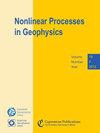连接经典数据同化和最佳传输
IF 2.4
4区 地球科学
Q3 GEOSCIENCES, MULTIDISCIPLINARY
引用次数: 0
摘要
摘要。因为最优传输作为物理空间中的位移插值而不是价值空间中的插值,它可以潜在地避免双重惩罚错误。因此,它为非负物理场比较提供了一个非常有吸引力的度量——瓦瑟斯坦距离——它可以进一步用于地球科学的数据同化。然而,这种距离的算法和数值实现并不简单。此外,它在典型数据同化问题中的理论表述面临概念上的挑战,导致文献中对该主题的贡献很少。我们以一种对经典数据同化和最优传输提供统一观点的方式来阐述问题。由此产生的OTDA框架既考虑了先前错误的经典来源,背景和观察,也考虑了代表这些背景和观察的状态之间的Wasserstein重心。我们表明,混合OTDA分析可以分解为一个涉及单个Wasserstein距离的更简单的OTDA问题,然后是一个忽略先前误差的Wasserstein重心问题,可以看作是一个McCann插值。我们还提出了一个不太具有启发性但直接的解决方案来解决完整的OTDA问题,其中包括其分析误差协方差矩阵的推导。由于这些理论的发展,我们能够在大多数经典数据同化方案的核心扩展经典的3D-Var/BLUE范式。所得到的形式非常灵活,可以解释稀疏、有噪声的观测和非高斯误差统计。简单的一维和二维的例子说明了这种统一所提供的新分析类型的丰富性。本文章由计算机程序翻译,如有差异,请以英文原文为准。
Bridging classical data assimilation and optimal transport
Abstract. Because optimal transport acts as displacement interpolation in physical space rather than as interpolation in value space, it can potentially avoid double penalty errors. As such it provides a very attractive metric for non-negative physical fields comparison – the Wasserstein distance – which could further be used in data assimilation for the geosciences. The algorithmic and numerical implementations of such distance are however not straightforward. Moreover, its theoretical formulation within typical data assimilation problems face conceptual challenges, resulting in scarce contributions on the topic in the literature. We formulate the problem in a way that offers a unified view on both classical data assimilation and optimal transport. The resulting OTDA framework accounts for both the classical source of prior errors, background and observation, together with a Wasserstein barycentre in between states that stand for these background and observation. We show that the hybrid OTDA analysis can be decomposed as a simpler OTDA problem involving a single Wasserstein distance, followed by a Wasserstein barycentre problem which ignores the prior errors and can be seen as a McCann interpolant. We also propose a less enlightening but straightforward solution to the full OTDA problem, which includes the derivation of its analysis error covariance matrix. Thanks to these theoretical developments, we are able to extend the classical 3D-Var/BLUE paradigm at the core of most classical data assimilation schemes. The resulting formalism is very flexible and can account for sparse, noisy observations and non-Gaussian error statistics. It is illustrated by simple one– and two–dimensional examples that show the richness of the new types of analysis offered by this unification.
求助全文
通过发布文献求助,成功后即可免费获取论文全文。
去求助
来源期刊

Nonlinear Processes in Geophysics
地学-地球化学与地球物理
CiteScore
4.00
自引率
0.00%
发文量
21
审稿时长
6-12 weeks
期刊介绍:
Nonlinear Processes in Geophysics (NPG) is an international, inter-/trans-disciplinary, non-profit journal devoted to breaking the deadlocks often faced by standard approaches in Earth and space sciences. It therefore solicits disruptive and innovative concepts and methodologies, as well as original applications of these to address the ubiquitous complexity in geoscience systems, and in interacting social and biological systems. Such systems are nonlinear, with responses strongly non-proportional to perturbations, and show an associated extreme variability across scales.
 求助内容:
求助内容: 应助结果提醒方式:
应助结果提醒方式:


